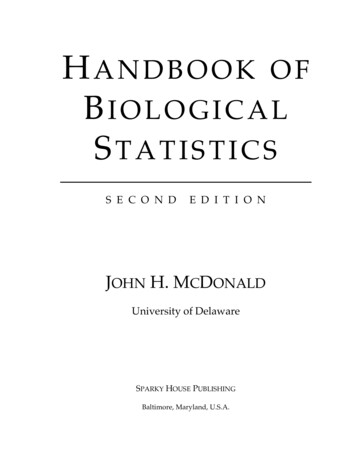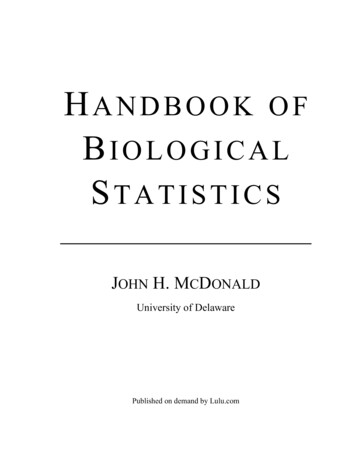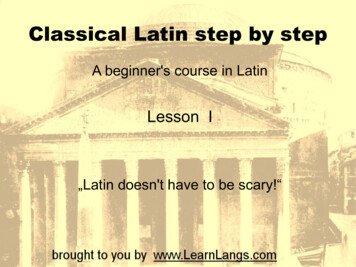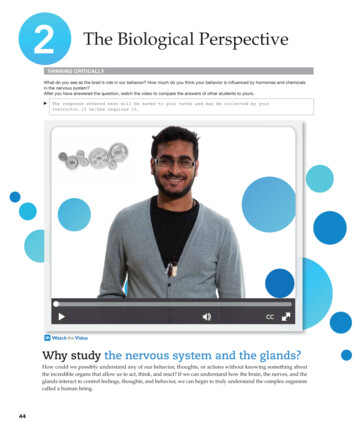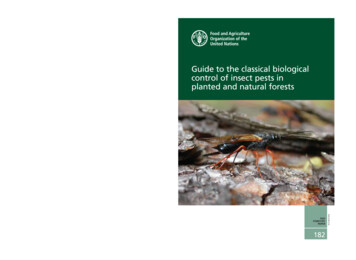
Transcription
0.66 cm spine for 112pg on 90g paper182182FAO FORESTRY PAPERInsect pests damage millions of hectares of forestworldwide each year. Moreover, the extent of suchdamage is increasing as international trade grows,facilitating the spread of insect pests, and as theimpacts of climate change become more evident.Classical biological control is a well-tried,cost-effective approach to the management ofinvasive forest pests. It involves the importing of“natural enemies” of non-native pests from theircountries of origin with the aim of establishingpermanent, self-sustaining populations capable ofsustainably reducing pest populations belowdamaging levels.A great deal of knowledge on classical biologicalcontrol has been accumulated worldwide in the lastfew decades. This publication, which was written bya team of experts, distils that information in a clear,concise guide aimed at helping forest-healthpractitioners and forest managers – especially indeveloping countries – to implement successfulclassical biological control programmes. It providesgeneral theory and practical guidelines, explains the“why” and “how” of classical biological control inforestry, and addresses the potential risks associatedwith such programmes. It features 11 case studies ofsuccessful efforts worldwide to implement classicalbiological control.ISBN 978-92-5-131335-03 1 3 3 5 0CA3677EN/1/03.19FAOFORESTRYPAPER182ISSN 0258-61507 8 9 2 5 1Guide to the classical biologicalcontrol of insect pests inplanted and natural forestsISSN 0258-6150FAO9Guide to the classical biological control of insect pests in planted and natural forestsGuide to the classicalbiological control ofinsect pests in plantedand natural forests
Guide to the classicalbiological control ofinsect pests in plantedand natural forestsbyMarc KenisBrett HurleyFernanda ColombariSimon LawsonJianghua SunCarlos WilckenRonald WeeksShiroma SathyapalaFOOD AND AGRICULTURE ORGANIZATION OF THE UNITED NATIONSRome, 2019FAOFORESTRYPAPER182
Required citation:Kenis, M.; Hurley, B.P.; Colombari, F.; Lawson, S.; Sun, J.; Wilcken, C.;Weeks, R. and Sathyapala, S. 2019. Guide to the classical biological control of insectpests in planted and natural forests, FAO Forestry Paper No. 182. Rome, FAO.Licence: CC BY-NC-SA 3.0 IGO.The designations employed and the presentation of material in this information product do not implythe expression of any opinion whatsoever on the part of the Food and Agriculture Organization of theUnited Nations (FAO) concerning the legal or development status of any country, territory, city or areaor of its authorities, or concerning the delimitation of its frontiers or boundaries. The mention of specificcompanies or products of manufacturers, whether or not these have been patented, does not imply thatthese have been endorsed or recommended by FAO in preference to others of a similar nature that are notmentioned.The views expressed in this information product are those of the author(s) and do not necessarily reflectthe views or policies of FAO.ISBN 978-92-5-131335-0 FAO, 2019Some rights reserved. This work is made available under the Creative Commons AttributionNonCommercial-ShareAlike 3.0 IGO licence (CC BY-NC-SA 3.0 IGO; igo/legalcode/legalcode).Under the terms of this licence, this work may be copied, redistributed and adapted for non-commercialpurposes, provided that the work is appropriately cited. In any use of this work, there should be nosuggestion that FAO endorses any specific organization, products or services. The use of the FAO logois not permitted. If the work is adapted, then it must be licensed under the same or equivalent CreativeCommons licence. If a translation of this work is created, it must include the following disclaimer alongwith the required citation: “This translation was not created by the Food and Agriculture Organizationof the United Nations (FAO). FAO is not responsible for the content or accuracy of this translation. Theoriginal [Language] edition shall be the authoritative edition.”Disputes arising under the licence that cannot be settled amicably will be resolved by mediationand arbitration as described in Article 8 of the licence except as otherwise provided herein. Theapplicable mediation rules will be the mediation rules of the World Intellectual Property Organizationwww.wipo.int/amc/en/mediation/rules and any arbitration will be conducted in accordance with theArbitration Rules of the United Nations Commission on International Trade Law (UNCITRAL).Third-party materials. Users wishing to reuse material from this work that is attributed to a third party,such as tables, figures or images, are responsible for determining whether permission is needed forthat reuse and for obtaining permission from the copyright holder. The risk of claims resulting frominfringement of any third-party-owned component in the work rests solely with the user.Sales, rights and licensing. FAO information products are available on the FAO website (www.fao.org/publications) and can be purchased through publications-sales@fao.org. Requests for commercial useshould be submitted via: www.fao.org/contact-us/licence-request. Queries regarding rights and licensingshould be submitted to: copyright@fao.org.Cover photo: The sirex woodwasp, a serious pest of Pinus species. B. HURLEY
iiiContentsForeword. viiAcknowledgements.viiiAcronyms. ix1 Introduction. 11.1 The threat to forests posed by insect pests. 11.2 Managing insect pests. 11.3 What is biological control?. 11.4 Classical biological control. 21.5 About this guide. 22 Classical biological control. 52.1 The benefits of classical biological control. 52.2 Natural enemies used in classical biological control. 52.3 Communication and classical biological control. 62.4 The classical biological control process. 63 Process leading to classical biological control. 93.1 Pest detection. 93.2 Pest identification and characterization. 103.3 Pest risk analysis. 123.4 Evaluating pest management options. 133.5 Studying natural enemies in an invaded region. 164 Implementing classical biological control.194.1 Reviewing potential biological control agents. 194.2 Studying natural enemies in a pest’s native range. 214.3 Importing biological control agents. 244.4 Rearing and multiplying biological control agents in quarantine. 314.5 Assessing the risk of introducing a biological control agent. 324.6 Releasing biological control agents from quarantine. 35
iv5 Monitoring and evaluating classical biological control. 435.1 Post-release monitoring. 435.2 Evaluating the success of a classical biological control programme. 486 Other considerations.516.1 The Nagoya Protocol. 516.2 Stakeholder engagement. 516.3 The way forward. 527 Case studies. 557.1 Coconut rhinoceros beetle in the Pacific region. 557.2 Great spruce bark beetle in Europe. 577.3 Asian chestnut gall wasp in North America, northern Asia and Europe. 597.4 Orthezia bug on Saint Helena. 617.5 Eucalypt gall wasp. 637.6 Bronze bug on Eucalyptus in Brazil. 657.7 Mango mealybug in West Africa. 677.8 Sirex woodwasp in Australasia, Africa, the Americas and Asia. 697.9 Winter moth in Canada and the United States of America. 717.10 Ambermarked birch leaf miner in Canada and theUnited States of America. 737.11 Fall webworm in China. 75Glossary. 79Annex: List of pests, biological control agents and tree hostsmentioned in the guide. 87References and further reading.91
vFigures1Stages, actions and decisions in a classical biological control programme. 72Floor plan for a basic physical containment/biosecurity level 2quarantine facility. 28Boxes1Categories of natural enemies used in classical biological control. 52Studying natural enemies in an invaded region. 163Classical biological control projects against the same insect pests indifferent countries. 194Key considerations when transporting a biological control agentinto an importing country. 255Basic requirements for quarantine facilities for importing insect-pestbiological control agents. 266Physical containment/biosecurity levels for containing biologicalcontrol agents securely. 267Key considerations for receiving biological control agents intoquarantine facilities. 298Key biological characteristics to be understood when rearingan insect pest and its biological control agent. 319Example of a parthenogenetic species used for classicalbiological control. 3210 Criteria for selecting non-target test species. 3311 Host-specificity study of native and non-native species as non-targets. 3512 Assessing biological control agent effectiveness: parasitism rates. 4613 Non-target effects of the biological control agentCompsilura concinnata. 47
B. HURLEYConifer forest inOntario, Canada
viiForewordInsect pests damage millions of hectares of forest worldwide each year. Moreover, theextent of such damage is increasing as international trade grows, facilitating the spreadof insect pests, and as the impacts of climate change become more evident. Globally, andespecially in developing economies, outbreaks of forest pests can have major consequencesfor the livelihoods of forest-dependent communities.FAO views the threat posed by forest insect pests very seriously. Pest management isan important element of Sustainable Development Goal 15 (“Life on Land”), especiallytarget 15.8: “By 2020, introduce measures to prevent the introduction and significantlyreduce the impact of invasive alien species on land and water ecosystems and control oreradicate the priority species”. FAO’s ongoing programme on integrated pest managementsupports the achievement of this target, including through classical biological control.Classical biological control is a well-tried, cost-effective approach to the managementof invasive pest species. It involves the importing of “natural enemies” (parasitoids,predators and pathogens) of non-native pests from their countries of origin with the aim ofestablishing permanent, self-sustaining populations capable of reducing pest populationsto below acceptable damage thresholds. Classical biological control is especially wellsuited as a management tool for exotic pests that invade new environments, and it canprovide long-term, efcacious control at minimal ongoing cost. It also poses risks and itis crucial, therefore, that it is implemented with adequate safeguards.A great deal of knowledge on classical biological control has been accumulated worldwidein the last few decades. This publication, which was written by a team of experts, distilsthat information in a clear, concise guide aimed at helping forest-health practitioners andforest managers – especially in developing countries – to implement successful classicalbiological control programmes. It provides general theory and practical guidelines, explainsthe “why” and “how” of classical biological control in forestry, and addresses the potentialrisks associated with such programmes. It features 11 case studies of successful efforts toimplement classical biological control around the world.I thank everyone involved in producing this document, especially the authors and all thosewho participated in the expert meetings that gave rise to the work. I have no doubt that theapplication of this guide in diverse situations will help in the safe, effective use of classicalbiological control and thereby in ensuring the health and productivity of the world’s forests.Hiroto MitsugiAssistant Director-GeneralFAO Forestry Department
viiiAcknowledgementsShiroma Sathyapala, FAO Forestry Officer (Forest Health and Protection), coordinatedthe preparation of this publication under the overall guidance of Eva Müller, Directorof Forestry Policy and Resources, FAO Forestry Department. Two international expertmeetings were convened to assist in preparing the publication, the first in Rome, Italy,in March 2017 and the second in Langkawi, Malaysia, in September 2017. FAO thanksCarl Rankin for facilitating both meetings as well as online consultations and for preparing a first draft of the document based on inputs received from experts. The followingmembers of a peer-review group are acknowledged for their contributions and commentson various drafts of the publication: independent reviewers Professor Timothy D. Paineand Dr Eston Mutitu; Avetik Nersisyan and Sandra Goritschnig from the InternationalPlant Protection Convention; Andrei Orlinski from the European and Mediterranean PlantProtection Organization; and Mette Løyche Wilkie from the FAO Forestry Department.FAO acknowledges the contributions made to the needs-assessment survey by members ofthe Asia-Pacic Forest Invasive Species Network, the Forest Invasive Species Network forEurope and Central Asia, the Near East Forest Health and Invasive Species Network, theForest Invasive Species Network for Africa, and Federica Urbani at FAO. Many thanksto technical editor Susan House, copyeditor Alastair Sarre and designer Kate Ferruccifor their contributions.FAO also thanks the authors of this guide: Dr Marc Kenis, Centre for Agricultureand Biosciences International, Switzerland; Dr Brett Hurley, Forestry and AgriculturalBiotechnology Institute, University of Pretoria, South Africa; Dr Fernanda Colombari,University of Padova, Italy; Dr Simon Lawson, University of the Sunshine Coast, Australia;Professor Carlos Wilcken, São Paulo State University, Brazil; Dr Jianghua Sun, Instituteof Zoology, Chinese Academy of Sciences, China; Dr Ronald D. Weeks, United StatesDepartment of Agriculture, United States of America; and Dr Shiroma Sathyapala,FAO, Rome.
ixAcronymsBCAbiological control agentBSbiosecurityCBCclassical biological controlCBDConvention on Biological DiversityFAOFood and Agriculture Organization of the United NationsIOBCInternational Organisation for Biological and Integrated ControlIPMintegrated pest managementIPPCInternational Plant Protection ConventionISPMInternational Standard for Phytosanitary MeasuresNPPOnational plant protection organizationPCphysical containmentPRApest risk analysisWHOWorld Health Organization
T. HAYEThe parasitoid Apechthiscompunctator parasitizinga boxwood tree moth(Cydalima perspectalis) pupa
1Introduction1.1The threat to forests posed by insect pestsPlanted and natural forests provide many economic, social and environmental benefits.For example, they help combat desertification, protect watersheds, regulate climate,conserve biodiversity and maintain social and cultural values. In economically developingcountries, forests help meet basic needs for food, medicines, timber, energy and fodder.Insect pest outbreaks damage about 35 million hectares of forests annually, mainly inthe temperate and boreal zones (FAO, 2010). Such outbreaks are increasing globally asthe volume and speed of international trade escalates and the climate changes.In planted and natural forests, endemic insects and tree diseases are integral componentsof ecosystems. The introduction of non-native insect pests to new areas where they haveno natural enemies, however, can have catastrophic impacts. Damage caused by invasiveforest insect pests can reduce tree growth and timber quality and production, causedeclines in biodiversity, significantly affect vital forest ecosystem functions and changeentire landscapes. Although native forest pests can have similar effects, usually these aremore sporadic and can be managed by modifications to management regimes.In economically developing countries, non-native forest insect pests can cause severeeconomic losses, affecting the livelihoods and food security of many forest-dependentpeople. It is crucial, therefore, to manage insect pests appropriately. Pest management isan important element of Sustainable Development Goal 15 (“Life on Land”), especiallytarget 15.8: “By 2020, introduce measures to prevent the introduction and significantlyreduce the impact of invasive alien species on land and water ecosystems and control oreradicate the priority species”.1.2Managing insect pestsForest insect pests can be managed by the deployment of resistant or tolerant germplasmand by chemical, cultural and biological means. These various methods can be appliedcompatibly as part of integrated pest management (IPM) – a widely accepted approachimplemented in both natural and planted forests worldwide (see section 3.4).1.3What is biological control?Biological control involves the use of “natural enemies” as an essential component ofIPM. In a broad sense, a natural enemy is an organism that causes the death or impairment of another organism. Biological control can be defined as using living naturalenemies (“beneficial organisms”) to control other living organisms (“pests”). InternationalStandard for Phytosanitary Measures (ISPM) 3 defines a biological control agent (BCA)as a “natural enemy, antagonist or competitor, or other organism, used for pest control”.The objective of all biological control programmes in forestry and agriculture is to reduce
2Guide to the classical biological control of insect pests in planted and natural foreststhe impacts of pests to below acceptable thresholds. Biological control can be used aloneor in combination with other control methods in IPM programmes.There are three main approaches to biological control:1. Augmentation biological control – increasing the density of native or non-nativenatural enemies with regular releases. Releases may be made- at the beginning of each season, when relatively few individuals of a naturalenemy are released (these are expected to reproduce during a certain period), or- as a single mass release of a natural enemy expected to result in immediate control.2. Conservation biological control – the manipulation of habitat with the aim ofenhancing the reproduction, survival and efficacy of natural enemies alreadypresent in an affected area.3. Classical biological control (CBC) – the introduction of a natural enemy of nonnative origin to control a pest, usually also non-native, with the aim of establishinga population of the natural enemy sufficient to achieve the sustainable control ofthe target pest.1.4Classical biological controlCBC is often a key component of IPM in forestry. It consists of controlling non-nativepests by importing natural enemies (parasitoids, predators or pathogens) from theircountries of origin. The objective is to establish permanent, self-sustaining populationsof natural enemies that will disperse and suppress a pest population or reduce its rate ofspread, including as part of wider IPM systems. Although, on its own, a CBC programmewill not eradicate an invasive pest species, it can help reduce the population to below anacceptable threshold of damage. CBC is particularly well-suited as a management tool fornon-native pests that invade new environments and can provide long-term, efficaciouscontrol at minimal ongoing cost.1.5About this guideThis guide has been written to enable forest-related personnel in economically developing countries to implement successful CBC programmes. It provides general theory andpractical guidelines, explains the “why” (background and understanding) and “how” offorest pest control using CBC, and features 11 case studies of the successful applicationof CBC worldwide. CBC can be used to target many kinds of organism, includinginvasive plants and pathogens. This guide is concerned with forest insect pests, althoughits recommendations may also be valid for agricultural ecosystems.Chapter 2 provides an introduction to some of the basic elements of a CBC programme.Chapters 3–5 examine the three main stages of a CBC programme, focusing especiallyon aspects of planning, implementation and the monitoring and evaluation of outcomes.Chapter 6 canvasses other important considerations, and Chapter 7 presents case studies.A glossary provides definitions of many of the technical terms used in this guide, and anannex lists the main species and genera of pests, BCAs and tree hosts described herein.This guide is designed to complement a key FAO Forestry Paper, Guide to theImplementation of Phytosanitary Standards in Forestry (FAO, 2011), and the International
Introduction3Standards for Phytosanitary Measures, especially ISPM 3: Guidelines for the Export,Shipment, Import and Release of Biological Control Agents and Other BeneficialOrganisms. Both these documents, which are available free of charge, should be consultedin tandem with this guide.
F. COLOMBARIA female of the parasitoidTorymus sinensis on a gall
52Classical biological control2.1The benefits of classical biological controlCBC is a permanent, self-sustaining form of pest control. These qualities give CBC animportant advantage over chemical and silvicultural pest-control methods as well asover the augmentation and conservation biological control methods. Once established,non-native natural enemies of targeted pests should require no further intervention, thuspotentially resulting in substantial cost savings and economic benefits. For example, theCBC project against the mango mealybug in Africa generated an estimated cost–benefitratio of 1:808 over 40 years (case study 7.7).1Successful CBC projects enable reductions in the use of insecticides, which hassubstantial benefits for human health and the environment. CBC programmes areincreasingly being developed to protect biodiversity and natural ecosystems where theuse of pesticides is not an option – such as in the case of the orthezia bug on the islandof Saint Helena (case study 7.4). CBC is also being used in protected areas – such as theGalapagos Islands, where the vedalia beetle (Rodolia cardinalis) has been introduced tohelp manage the impact of cottony cushion scale (Icerya purchasi), a plant pest.2.2Natural enemies used in classical biological controlIn CBC, one or more of a pest’s natural enemies are selected as potential BCAs. Theymay be parasitoids, predators or pathogens (Box 1), and they are most often sourcedfrom a pest’s native range, although related taxa from other invaded regions or elsewheremay also be considered.BOX 1Categories of natural enemies used in classical biological controlParasitoids are parasitic organisms (mostly insects in the orders Diptera and Hymenoptera) thatdevelop in a single host, usually killing it. Parasitoids can parasitize all insect developmentalstages, from eggs to adults. They make up most of the agents used in classical biologicalcontrol (CBC) programmes because they tend to be more host-specific than predators andBox continues on next page1Note that it is usually easier to calculate the economic benefits of CBC for agricultural pests than forforestry pests, partly because measuring differences in tree growth rates or timber production overrelatively long rotations requires considerably more investment and time compared with measuring thegrowth of annual agricultural crops or the loss of fruit production.
6Guide to the classical biological control of insect pests in planted and natural forestsBox continuedpathogens. For example, the winter moth in Canada has been controlled successfully throughthe introduction of a hymenopteran parasitoid, Agrypon flaveolatum, and a dipteranparasitoid, Cyzenis albicans (case study 7.9 describes this CBC programme; see case studies7.3, 7.5–7.7 and 7.9–7.11 for other examples of the use of parasitoids in CBC).Predators are entomophagous insects that feed on more than one prey in their lifetime.Larvae, nymphs and adults of many insect orders can be predators and may feed on alldevelopmental stages of their prey. Currently, predators tend to be less-favoured thanparasitoids in CBC programmes because their wider host ranges increase the risk of nontarget effects. Nevertheless, there are many exceptions, and several specific predators havegenerated some of the biggest successes in CBC against tree pests, such as Rhizophagusgrandis against the great spruce bark beetle (case study 7.2), Hyperaspis pantherina againstthe orthezia bug (case study 7.4) and the vedalia beetle against the cottony cushion scale.Entomopathogens (viruses, fungi and microsporidia, and nematodes) have been usedin CBC programmes to a much lesser extent than parasitoids and predators. An example isthe nudivirus used against the coconut rhinoceros beetle (case study 7.1). Various groupsof nematodes are well-known natural enemies of insects, but they are rarely used in CBCprogrammes. A notable exception is the deployment of a parasitic nematode against thesirex woodwasp (case study 7.8).2.3Communication and classical biological controlAll CBC programmes should include awareness campaigns aimed at the programme’s mainbeneficiaries (e.g. farmers, foresters and consumers). The objectives of such campaignsshould be clear – such as to inform stakeholders about the intention to implement CBCand to provide updates on the process. It is important to initiate awareness campaignsvery early on – as soon as the decision has been made to use CBC. Awareness campaignsmust be maintained throughout the duration of a CBC programme using appropriatemedia to reach all affected stakeholders, including the public.2.4The classical biological control processCBC programmes have two main phases (Figure 1):1. the process to develop a CBC programme (described in Chapter 3); and2. the implementation of a CBC programme (described in Chapter 4; see alsoChapter 5 on monitoring and evaluation, which are parts of implementation).
Classical biological control7FIGURE 1Stages, actions and decisions in a classical biological control programmePest isdetectedIdentify and characterize pestAssess pest impact/risksSerious pest?YESEvaluate pest managementoptions, including classicalbiological control (CBC)Study natural enemies(potential biologicalcontrol agents – BCAs)in the invaded regionHas an effectiveBCA been found?CBC selected as part
Classical biological control is a well-tried, cost-effective approach to the management of invasive forest pests. It involves the importing of "natural enemies" of non-native pests from their countries of origin with the aim of establishing permanent, self-sustaining populations capable of sustainably reducing pest populations below



